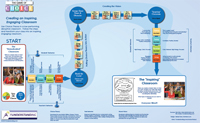What to look for in this infographic
Goals are necessary but not sufficient to create an inspiring classroom. Sure, goals are essential. Teachers need to know where they want to go in order to select the best strategies to get there. And goals work just fine when you are operating in isolation.

Goals are significantly more complicated, however, when other people are involved – and teaching certainly involves working with others. Just because a teacher has a nicely articulated set of goals doesn’t mean she can easily turn them into reality. In all likelihood, she has 20-30 students in her classroom and there’s no reason to believe they have the same goals for the time that they will be together. Establishing your goal is a good starting point, but it’s not enough when success ultimately depends upon a group working collaboratively.
What does this mean for the classroom teacher? Make it your priority to establish a shared vision of success with your students. When everyone is motivated to achieve the same thing, success is attainable. When you don’t take the time to establish a shared vision with your students, they might be motivated to achieve a very different set of goals from yours and you’ll encounter lots of unnecessary conflict.
Let me describe the process so you can use it immediately.
Building a Shared Vision of an Inspiring Classroom: The Process
1. Begin by asking your students if they want to have a successful experience in your class.
2. Define “successful” by explaining you want the classroom to be a productive, enjoyable environment. Ask them if they want that as well.
3. Once the students affirm that they define success as you do – productive and enjoyable – say something like this: “Since we want the same thing, we have a shared vision for this class and can make this a great class. We just need to get more specific.”
4.Divide the class into groups of four or five students each. Give each group a piece of chart paper and some markers.
5.Draw a circle on the board at the front of the room. Tell the class, “This circle represents what we want – an inspiring classroom where we can enjoy ourselves and be productive. In this circle, we are going to identify those things that we should do and qualities we should display that will help create the class we want.” Depending upon the age and ability of your students, you might want to provide some examples like “being prepared for class” and “respect.” Give the students about ten minutes to work in their groups. Note: Don’t give too many examples. The success of this activity requires that students be active participants in what you create.
6. Have each group share what they put in their “inspiring classroom” circle. Expect a lot of repetition. Those items that are noted by some groups but not others need to be considered by the whole class. If the class decides to include the item, add it to your composite circle. Leave out those items that are not endorsed by the whole class.
7. If you have too many items or some are redundant (i.e. “be on time” and “be prompt”), combine and cluster items.
8. Return to the board and draw a rectangle at the base of the circle. Say, “We have done a great job identifying the values and the behaviors to create a productive, enjoyable class. Now it’s time to look at some things that can get in our way. Think of things that will make it difficult for us to have the classroom we want. Things like ‘making fun of others’ or ‘cheating.’ In your groups, draw a rectangle and identify things to avoid.” Give the student five to ten minutes to do this.
9. Follow the same procedure you used for the inspiring classroom circle and create a composite list of behaviors to avoid.
10. End by saying, “I will get this typed and copied for us to look at as a group tomorrow.”
Follow-up
The next day, distribute a printed “inspiring classroom” chart to each student and say, “I have compiled everything we agreed to yesterday. Let’s take a few minutes to review what we created.” Quickly review everything you have in both the circle and rectangle. “If we do the things in the circle and avoid things in the rectangle, will we have the kind of classroom we want: one where we can be productive and enjoy ourselves?” Once the students agree that this is what they want and their inspiring classroom chart offers them a blueprint for success, end the discussion by saying, “OK. We know what we want. We know what we need to do. Let’s do it!”
• Note: Your use of language is important. I often use words and phrases like, “enjoy ourselves and be productive,” “the kind of classroom we want,” etc. Even though it’s repetitious, it’s helpful for students to connect “success” with “being productive” and pairing “being productive” with “enjoying ourselves.” By repeatedly talking about “the kind of classroom we want,” you are tapping into the internal motivation of your students. We are all internally motivated by what we want. The artful use of language can help students stay conscious about what it is that they want when they are in your classroom.
Refer to your inspiring classroom chart on a regular basis. Have students keep their copy of the chart in their binder. Enlarge the chart and post it in a prominent place in the classroom so it’s something they see every day when they enter the room. Rather than wait until you have major problems, as soon as you notice students engaging in unwanted behaviors, have them look at their charts to remind themselves of what they really want in your class. This will help them stay appropriately focused and prevent minor problems from becoming major distractions.
Conclusion
Do yourself a favor. Don’t just set goals for yourself. Take the next step. Build a shared vision with your students of an inspiring classroom, one characterized by enjoyment and productivity. It takes very little time and this collaborative process will pay dividends.
Note: This material was excerpted from “Beyond Goals: Creating an Inspiring Classroom”